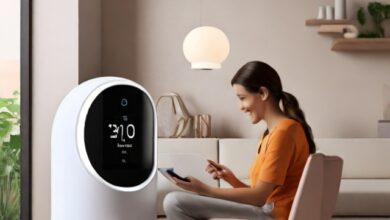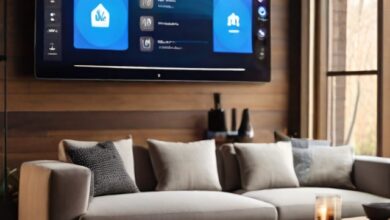Best budget-friendly smart home devices for energy savings 2023

Introduction
As we step into 2023, the integration of smart home devices in our daily lives is not just a trend but a necessity for a sustainable future. With energy costs on the rise and environmental concerns gaining priority, homeowners are increasingly looking towards smart technology for solutions. The appeal of smart home devices lies in their ability to offer significant energy savings without breaking the bank. This article explores the best budget-friendly smart home devices available in 2023, focusing on their energy-saving potential. From smart thermostats to energy-efficient lighting solutions, we will delve into how these innovative gadgets can make your home more eco-friendly and cost-effective.
The Importance of Energy Efficiency in 2023
In 2023, the importance of energy efficiency in households cannot be overstated. With growing environmental concerns and the rising cost of energy, efficient use of resources has become a critical issue. This is where smart home devices come into play, offering an innovative solution to reduce energy consumption and, consequently, the carbon footprint of homes.
Energy efficiency is not just about saving on utility bills; it’s a significant step towards combating climate change. By optimizing the way we use electricity, we can decrease the demand on power plants and reduce greenhouse gas emissions. Smart home devices are at the forefront of this movement, giving homeowners control over their energy usage in ways that were not possible before.
These devices, equipped with sensors and intelligent algorithms, can automate and optimize the energy consumption of various household systems. They can adapt to your lifestyle, learning your preferences, and adjusting settings to ensure energy is used judiciously, thereby promoting a sustainable living environment.
Criteria for Choosing Smart Home Devices
When selecting smart home devices, especially for the purpose of energy savings, there are several key criteria to consider:
- Energy Efficiency: Look for devices that are specifically designed to reduce energy consumption. Check if they have energy-saving features or modes.
- Cost: Budget-friendly doesn’t mean you have to compromise on quality. Look for devices that offer a good balance between cost and functionality.
- User Reviews: Customer reviews can provide real-world insights into how the device performs in everyday scenarios.
- Compatibility: Consider how the device will fit into your existing smart home system. Compatibility with platforms like Google Home, Amazon Alexa, and Apple HomeKit can be a significant advantage.
- Ease of Use: The device should be user-friendly, with a straightforward setup and intuitive controls.
- Durability and Warranty: Reliable performance and a warranty can save you from future expenses.
By keeping these criteria in mind, you can choose smart home devices that are not only budget-friendly but also effective in reducing your energy bills.
Top Budget-Friendly Smart Thermostats
Smart thermostats are a cornerstone of energy-efficient home automation. Here’s a look at some of the best budget-friendly options in 2023:
- Model 1:
- Features: This thermostat offers programmable schedules, remote control via an app, and compatibility with major smart home systems.
- Energy Savings: With intelligent scheduling and learning capabilities, it optimizes heating and cooling for maximum efficiency.
- Price Range: It’s priced competitively, offering high-end features without a hefty price tag.
- Model 2:
- Features: Known for its sleek design and user-friendly interface, this model includes geofencing technology to adjust the temperature based on your location.
- Energy Savings: The geofencing feature ensures that energy is not wasted on heating or cooling an empty home.
- Price Range: Affordable for the features it provides, making it a great value for money.
- Model 3:
- Features: This model stands out for its easy installation and straightforward controls, perfect for those new to smart home technology.
- Energy Savings: Offers basic programmable features that help reduce unnecessary energy usage.
- Price Range: One of the most budget-friendly options on the market.
These smart thermostats strike a balance between cost, functionality, and energy savings, making them ideal choices for budget-conscious homeowners looking to upgrade their home in 2023.
Energy-Efficient Smart Lighting Solutions
Lighting is a significant part of a home’s energy consumption, and smart lighting solutions can play a crucial role in reducing it. Here are some budget-friendly and energy-efficient smart lighting options:
- Smart LED Bulbs:
- These bulbs are more energy-efficient than traditional incandescent bulbs and can be controlled remotely via apps. Look for options that allow you to adjust brightness and even color temperature.
- Many smart LED bulbs are compatible with voice assistants for easy control.
- Smart Light Switches:
- If you prefer not to replace all your bulbs, smart light switches are an alternative. They let you control the lighting in your home remotely and can be programmed for specific times.
- Some models include features like dimming, which can further save energy.
- Motion Sensor Lights:
- Ideal for areas like hallways or bathrooms, where lights only need to be on when someone is present. These lights can significantly reduce energy waste.
By integrating these smart lighting solutions, you can enjoy both the convenience of modern technology and the benefits of energy savings.
Smart Plugs and Power Strips for Energy Management
Smart plugs and power strips are simple yet effective tools for managing energy usage in your home. Here’s how they can contribute to energy savings:
- Smart Plugs:
- These devices plug into your standard electrical outlets, allowing you to turn any appliance into a smart device that can be controlled remotely.
- They are particularly useful for appliances that consume energy in standby mode, as you can completely turn them off when not in use.
- Energy Monitoring Smart Plugs:
- Some smart plugs come with energy monitoring features, letting you track the power usage of connected devices. This information can be invaluable in identifying and reducing energy waste.
- Smart Power Strips:
- Smart power strips can control multiple devices simultaneously. They often include scheduling features and can be controlled via smartphone apps.
- Like smart plugs, they help reduce energy consumption of devices in standby mode.
Investing in these devices can help you significantly lower your energy bills by giving you greater control over your home’s energy consumption
Intelligent Home Energy Monitors
Intelligent home energy monitors are an essential tool for homeowners looking to reduce their energy consumption. Here’s how they can help:
- Functionality:
- These monitors connect to your home’s electricity meter to provide real-time data on energy usage. They often come with apps that display this information in an easily digestible format.
- Some models can even track the energy usage of individual appliances, helping you identify where most of your energy is going.
- Benefits:
- By understanding your energy consumption patterns, you can make informed decisions to reduce unnecessary usage.
- These devices can help detect when appliances are inefficient or malfunctioning, potentially saving you money on both energy and maintenance.
- Cost-effectiveness:
- While there’s an upfront cost to purchasing a home energy monitor, the long-term savings on your energy bills can be significant.
- They are particularly useful for those looking to make their homes more eco-friendly and cost-efficient.
Incorporating an intelligent home energy monitor into your smart home setup can be a game-changer in managing and reducing your household energy consumption.
Smart Water Heaters and Controllers
Water heating is a significant contributor to home energy use. Smart water heaters and controllers can offer both energy savings and enhanced convenience:
- Smart Water Heaters:
- These are designed to be more energy-efficient than traditional models. They can be programmed to heat water only when needed, reducing standby energy loss.
- Some smart water heaters allow remote control and scheduling via smartphone apps, enabling you to adjust settings on the go.
- Smart Water Heater Controllers:
- For those who don’t want to replace their existing water heater, a smart controller can be an effective alternative. It attaches to your current water heater, allowing for smart functionality.
- These controllers can learn your usage patterns and adjust heating schedules for optimal efficiency.
- Energy Savings:
- By optimizing water heating schedules and avoiding unnecessary heating, these devices can significantly reduce your energy bills.
- They also offer the convenience of adjusting settings remotely, perfect for managing energy use while away from home.
Investing in smart water heating solutions is a wise decision for those looking to cut down on energy consumption in a significant area of home utilities.
Integration and Smart Home Ecosystems
Integrating various smart devices into a cohesive smart home ecosystem can enhance both energy efficiency and convenience. Here are some tips for successful integration:
- Choosing Compatible Devices:
- Ensure that the smart devices you choose are compatible with each other and can be controlled through a common platform or app.
- Consider ecosystems like Google Home, Amazon Alexa, or Apple HomeKit for streamlined integration and control.
- Utilizing Centralized Control Apps:
- Many smart home devices can be managed through centralized apps, allowing you to control lighting, heating, and other systems from one place.
- Look for apps that offer comprehensive control and customization options for your devices.
- Creating Automated Routines:
- Set up automated routines that adjust your home’s energy usage based on time of day, occupancy, or specific triggers. For example, lights can turn off automatically when no one is in the room.
- Use smart sensors in conjunction with other devices for more efficient automation, such as turning off the heating when a window is opened.
- Regular Updates and Maintenance:
- Keep your devices updated with the latest software to ensure they operate efficiently and securely.
- Regularly check and maintain your smart devices to prolong their life and performance.
By thoughtfully integrating your smart home devices, you can create an efficient, responsive, and user-friendly ecosystem that saves energy and simplifies your daily routine.
Conclusion
As we embrace the advancements in smart home technology, particularly in 2023, it’s clear that energy efficiency is more achievable and affordable than ever before. For homeowners looking to reduce their carbon footprint and save on energy bills, investing in budget-friendly smart home devices is a wise and forward-thinking choice. From smart thermostats that learn your schedule to intelligent lighting solutions and energy monitors, each device plays a crucial role in creating a more sustainable living environment.
The integration of these devices not only contributes to significant energy savings but also enhances the overall quality of life, offering convenience and control at your fingertips. As you embark on your journey to a smarter, more energy-efficient home, remember that the key is to start small and expand your system over time, always keeping compatibility and your personal needs in mind.
Frequently Asked Questions
Are smart home devices really effective in saving energy?
Yes, smart home devices are designed to optimize energy usage, which can lead to significant savings. For example, smart thermostats adjust heating and cooling based on your habits, reducing wasted energy.
How can smart lighting help save energy?
Smart lighting, especially LED bulbs, consumes less power. Additionally, features like scheduling, dimming, and motion sensors ensure lights are on only when needed.
What are the most cost-effective smart home devices to start with?
Smart thermostats and LED lighting are great starting points. They offer noticeable energy savings and are relatively easy to install and use.
Can smart plugs really make a difference in energy consumption?
Yes, by using smart plugs, you can turn off standby power to appliances when not in use, which can contribute to energy savings over time.



